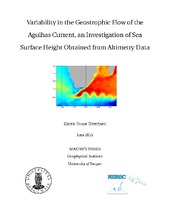| dc.description.abstract | The distinct and robust structure of the greater Agulhas Current regime southeast of southern Africa was depicted in the spatial pattern of the absolute dynamic topography. As a part of Work Package 3: Environmental driver, indicators, interactions and variability, and under Key Question 7: What are the physical drivers of annual cycles and seasonal events affecting marine ecosystems in the oceans of southern Africa?, this thesis investigated the variability of the Agulhas Current system through altimetry data from Aviso and model simulation data from HYCOM. The seasonal absolute dynamic topography anomalies are slightly higher and the seasonal geostrophic velocities are slightly stronger in the austral summer and fall compared to the winter and spring seasons. In the Agulhas Return Current the along-track altimetry data (track 96) showed clear interannual variability. Spectral analysis indicated that the dominating variability have periods of 1.8 and 4.3 years. In comparison, no interannual variability was detected for the Agulhas Current, except for the occasional negative anomalies indicating the passages of meanders, known as Natal Pulses. The Agulhas Current simulated by HYCOM corresponded well to that observed by the gridded altimetry data. The mean position of the Agulhas Return Current, however, was about two degrees too far south and lacked the characteristic meanders that were well displayed by the gridded altimetry data. Moreover, also the mean position of the Agulhas Retroflection simulated by HYCOM differed from that observed by the altimetry data. The position of the Agulhas Retroflection represented by HYCOM data varied more than 18 degrees in east-west direction, with its westernmost position at 5<degrees>E. In contrast, the gridded altimetry data depicted an east-west variation of about seven degrees, with its westernmost position at 14<degrees>E.No reliable indicator of the retroflection position was found, most likely due to the high non- linear and complex dynamics that are present in this region. | en_US |
